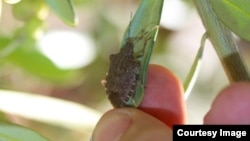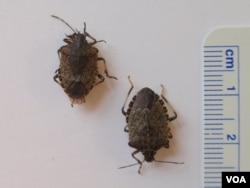AURORA, OREGON —
A smelly invasive bug continues to spread across the United States, alarming both farmers and scientists.
The name of this insect is a mouthful: the brown marmorated stink bug. Native to East Asia, the insect is causing crop losses from coast to coast in America. Researchers are working on control measures, but some of those come with their own worries.
One way scientists are following the spread of the brown marmorated stink bug is by setting traps. There are four traps at the edge of a blueberry field at Oregon State University's North Willamette research farm.
OSU entomologist Vaughn Walton points to a brown bug with a body shaped like a medieval shield and distinctive white stripes on its antennae. It's about the size of the fingernail on your ring finger.
It's called a stink bug for good reason. Many people say it's like a cilantro flavor," said Walton. "Some of the people in my lab used to like cilantro. Now they hate cilantro."
Here's why this bug invasion raises alarms. A stink bug can transmit that flavor into berries and fruit when it feeds. It can hide in wine grape clusters and then taint the juice when the grapes are crushed.
Early season attacks cause berries and nuts to shrivel. Stink bug bites leave blemishes on vegetables. U.S. Department of Agriculture research entomologist Tracy Leskey, who works on fruit trees in West Virginia, says the greatest crop damage has been reported in the mid-Atlantic region.
"Left untreated it would be a substantial loss," Leskey said. "In places where we are not controlling the insect for experimental purposes, we easily see 100 percent injury in those fruit."
North America has more than 200 native stink bug species, but farmers don't worry about most of them. They are focused on the more voracious variety that comes from East Asia. Scientists first detected it in the United States in Pennsylvania, in the late 1990's.
Vaughn Walton says the invasive species has multiplied and spread in all directions from there. "They are really good hitchhikers. They move on cars, on cargo, on trains and stuff like that."
The Asian stink bug has now been detected in 40 U.S. states and several Canadian provinces.
Back in Oregon's Willamette Valley, the bug is showing up in commercial crops for the first time this year.
"Hopefully we'll learn how to control this pest," said farmer Michelle Armstrong, who grows sweet corn and vegetables. "We definitely see it as a major threat."
The U.S. Agriculture Department is funding a number of university studies looking into control measures, but Armstrong says nothing has come on the market yet that specifically targets the brown marmorated stink bug.
"That's part of the worries for the growers," she said. "As a grower myself, what will I do when this pest gets in my field? I don't have a lot of options. We don't want to spray more than we have to."
Powerful insecticides do kill the bug, but also take out beneficial insects farmers want to keep around. So other options are getting a look. One is mass trapping using pheromone lures. The Oregon State science team says the long term solution probably involves bringing in the stink bug's natural predators which exist in East Asia.
"There's a wide range of parasitoids and predators from there," Walton said. "We've imported them. They're in quarantine. You can't release them because they can potentially affect other good bugs that we don't want to be affected."
The Agriculture Department says it will take several more years of research before scientists are more certain there won't be unintended consequences from introducing another non-native species onto U.S. farms.
The name of this insect is a mouthful: the brown marmorated stink bug. Native to East Asia, the insect is causing crop losses from coast to coast in America. Researchers are working on control measures, but some of those come with their own worries.
One way scientists are following the spread of the brown marmorated stink bug is by setting traps. There are four traps at the edge of a blueberry field at Oregon State University's North Willamette research farm.
OSU entomologist Vaughn Walton points to a brown bug with a body shaped like a medieval shield and distinctive white stripes on its antennae. It's about the size of the fingernail on your ring finger.
It's called a stink bug for good reason. Many people say it's like a cilantro flavor," said Walton. "Some of the people in my lab used to like cilantro. Now they hate cilantro."
Here's why this bug invasion raises alarms. A stink bug can transmit that flavor into berries and fruit when it feeds. It can hide in wine grape clusters and then taint the juice when the grapes are crushed.
Early season attacks cause berries and nuts to shrivel. Stink bug bites leave blemishes on vegetables. U.S. Department of Agriculture research entomologist Tracy Leskey, who works on fruit trees in West Virginia, says the greatest crop damage has been reported in the mid-Atlantic region.
"Left untreated it would be a substantial loss," Leskey said. "In places where we are not controlling the insect for experimental purposes, we easily see 100 percent injury in those fruit."
North America has more than 200 native stink bug species, but farmers don't worry about most of them. They are focused on the more voracious variety that comes from East Asia. Scientists first detected it in the United States in Pennsylvania, in the late 1990's.
Vaughn Walton says the invasive species has multiplied and spread in all directions from there. "They are really good hitchhikers. They move on cars, on cargo, on trains and stuff like that."
The Asian stink bug has now been detected in 40 U.S. states and several Canadian provinces.
Back in Oregon's Willamette Valley, the bug is showing up in commercial crops for the first time this year.
"Hopefully we'll learn how to control this pest," said farmer Michelle Armstrong, who grows sweet corn and vegetables. "We definitely see it as a major threat."
The U.S. Agriculture Department is funding a number of university studies looking into control measures, but Armstrong says nothing has come on the market yet that specifically targets the brown marmorated stink bug.
"That's part of the worries for the growers," she said. "As a grower myself, what will I do when this pest gets in my field? I don't have a lot of options. We don't want to spray more than we have to."
Powerful insecticides do kill the bug, but also take out beneficial insects farmers want to keep around. So other options are getting a look. One is mass trapping using pheromone lures. The Oregon State science team says the long term solution probably involves bringing in the stink bug's natural predators which exist in East Asia.
"There's a wide range of parasitoids and predators from there," Walton said. "We've imported them. They're in quarantine. You can't release them because they can potentially affect other good bugs that we don't want to be affected."
The Agriculture Department says it will take several more years of research before scientists are more certain there won't be unintended consequences from introducing another non-native species onto U.S. farms.

